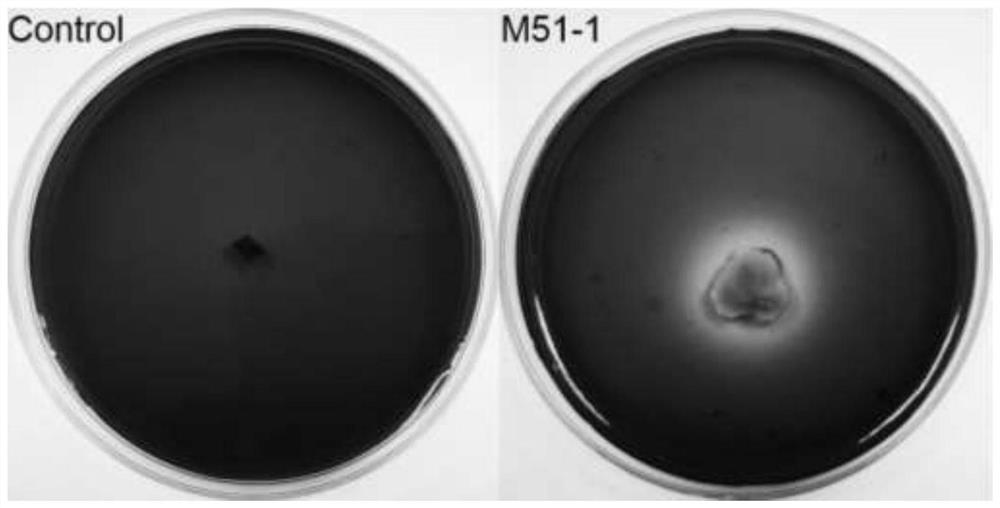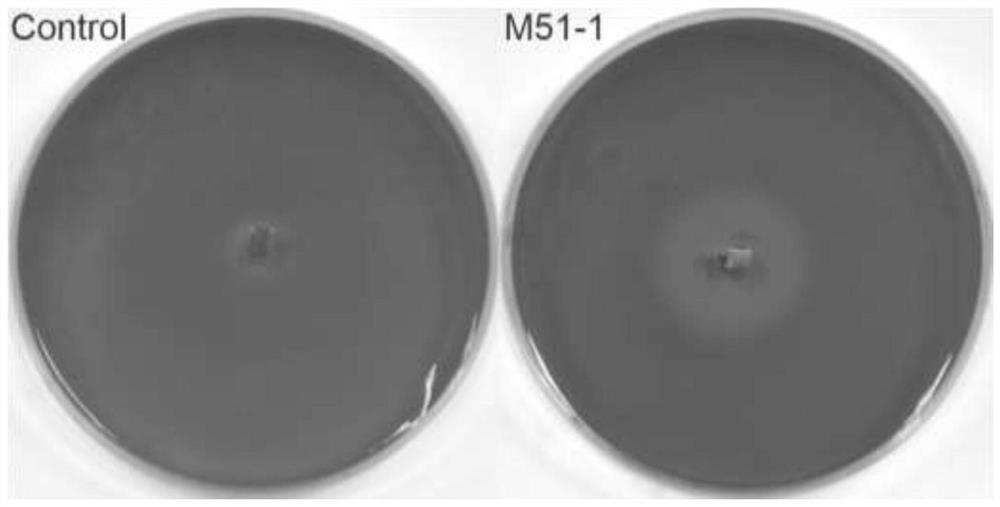Neosporum apescifolia with antibacterial ability and lignocellulose degrading activity and its application
A technology of lignocellulose and Pantotheca, applied in fungi, fungicides, microorganism-based methods, etc., can solve the problem of not mentioning the bacteriostatic activity of Penicillium oxalicum, etc.
- Summary
- Abstract
- Description
- Claims
- Application Information
AI Technical Summary
Problems solved by technology
Method used
Image
Examples
Embodiment 1
[0020] Embodiment 1, isolation and cultivation of bacterial strain M51-1
[0021] 1. Configuration of isolation and culture medium
[0022] MEA (separation) medium: Maltose extract (malt extract, Oxoid) 20g, dissolved in an appropriate amount of ultrapure water, added 15g of agar, and the volume of ultrapure water was adjusted to 1L. After sterilization, cool at room temperature to 45°C, and add streptomycin sulfate and tetracycline hydrochloride at final concentrations of 0.05g / L and 0.02g / L to inhibit bacterial contamination.
[0023] PDA (cultivation) medium: 200g of potatoes, peeled, cut into small pieces, boiled with ultrapure water, filtered with four layers of gauze, added with 20g of glucose, 15g of agar, and adjusted to 1L with ultrapure water. After sterilization, cool at room temperature to 45°C, and add streptomycin sulfate and tetracycline hydrochloride at final concentrations of 0.05g / L and 0.02g / L to inhibit bacterial contamination.
[0024] 2. Isolation and c...
Embodiment 2
[0028] Embodiment 2, molecular biological identification of bacterial strain M51-1
[0029] 1. Strain DNA extraction and PCR amplification
[0030] Pick the purely cultured fungal hyphae into a 1.5ml sterile centrifuge tube, and use the DNeasy Plant Mini Kit (Qiagen) kit to extract the fungal DNA. Using DNA as a template, the internally transcribed spacer sequence (ITS) was amplified, and the primers used were ITS1F: TCCGTAGGTGAACCTGCGG; ITS4: TCCTCCGCTTATTGATATGC.
[0031] A total of 25 μl of the amplification system: template DNA, 1 μl; forward and reverse primers, 0.5 μl each; Taq enzyme, 0.2 μl; dNTP, 2 μl; Buffer, 2.5 μl; sterile ultrapure water, 18.3 μl. The PCR amplification program included: 94°C pre-denaturation, 4min; 35 cycles, including 94°C pre-denaturation for 40s, 55°C annealing for 50s, 72°C extension for 1min; final extension for 10min.
[0032] 2. Sequence determination and species identification
[0033] After amplification and sequencing, the obtained IT...
Embodiment 3
[0037] Embodiment 3, the antibacterial ability of bacterial strain M51-1 (improves the resistance ability of plant to pathogenic bacteria)
[0038] The strain M51-1 (Pezicula neosporulosa) and the pathogen Fusarium oxysporum (Fusarium oxysporum) were inoculated on PDA plates respectively, and cultured at 25°C in the dark for 7 days.
[0039] Treatment group: pick a small amount of equal bacterial blocks of the two strains (about 0.5×0.5cm in size) in the PDA medium, respectively located at both ends of the diagonal of the plate and 1cm away from the edge; one end of the control group was inoculated with oxysporum Fusarium, with an agar block at the other end, cultured in the dark for 10 days. Measure the strain radius of the treatment group and the control group with a ruler, and calculate the bacteriostatic rate. like figure 1 As shown, the pathogenic bacteria colony of the treatment group (M51-1) was significantly smaller than that of the control group (control), indicatin...
PUM
 Login to View More
Login to View More Abstract
Description
Claims
Application Information
 Login to View More
Login to View More - R&D
- Intellectual Property
- Life Sciences
- Materials
- Tech Scout
- Unparalleled Data Quality
- Higher Quality Content
- 60% Fewer Hallucinations
Browse by: Latest US Patents, China's latest patents, Technical Efficacy Thesaurus, Application Domain, Technology Topic, Popular Technical Reports.
© 2025 PatSnap. All rights reserved.Legal|Privacy policy|Modern Slavery Act Transparency Statement|Sitemap|About US| Contact US: help@patsnap.com



